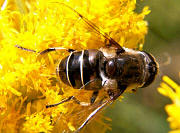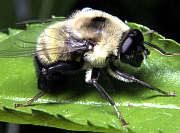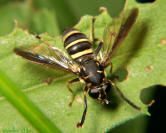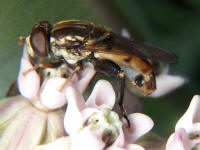| The hover flies are a large group of superbly beneficial insects. Their coloring and movements of most species mimic bees or wasps — they are either stout-bodied and covered with hair, resembling a bumble bee, or boldly patterned with yellow, orange and black, resembling aculeate (stinging) wasps. Some species even go so far as to wave their front legs in front of their face to mimic the jointed antennae of aculeate wasps. This phenomenon is called Batesian mimicry, indicating that defenseless organisms resemble or "mimic" dangerous or unpalatable models.
Adult hover flies require nectar or honeydew and pollen to ensure their reproduction (as well as to power their physical activities), and larvae generally require aphids for breakfast, lunch and dinner to complete their development. However, in the absence of aphids, larvae of some species can subsist and develop entirely on diets of pollen [1].
Quite a few flower fly species feed on aphids (aphidophagous). All are in the subfamily Syrphinae. Common aphidophagous flower flies in California vegetable crops include Toxomerus marginatus, Allograpta obliqua, Syrphus opinator among many others.
Syrphid flies are routinely used as a biological control in the lettuce fields of California's vegetable-producing regions, where the fly's larvae are generally effective in controlling lettuce aphid (Nasonovia ribisnigri). It is primarily the Syrphidae that enable organic romaine growers on California's central coast to produce harvestable crops.
Syrphidae larvae are, in turn, parasitized by wasps in the Hymenoptera families Ichneumonidae and Pteromalidae [1].

Look closely, and you can see the pubescence on the compound eyes in silhouette. Transverse Flower Fly – Eristalis transversa
Most hover flies are between 5-20 mm long, brightly colored in yellow and black, and have large compound eyes that nearly cover the head. One rule of thumb for identifying hover fly gender is, if the eyes meet at the top of the head, it's a male specimen. Each wing has a characteristic fold, or "false vein" which can be visible to the naked eye – it is located anterior to the first large vein that runs all the way to the outer margin of the wing. Of course, being true flies, they have only one pair of wings, plus the characteristic halteres, or bulb-like organs that evolved from the second pair of flying wings. In Syrphid flies, however, the halteres are fairly inconspicuous. |


















